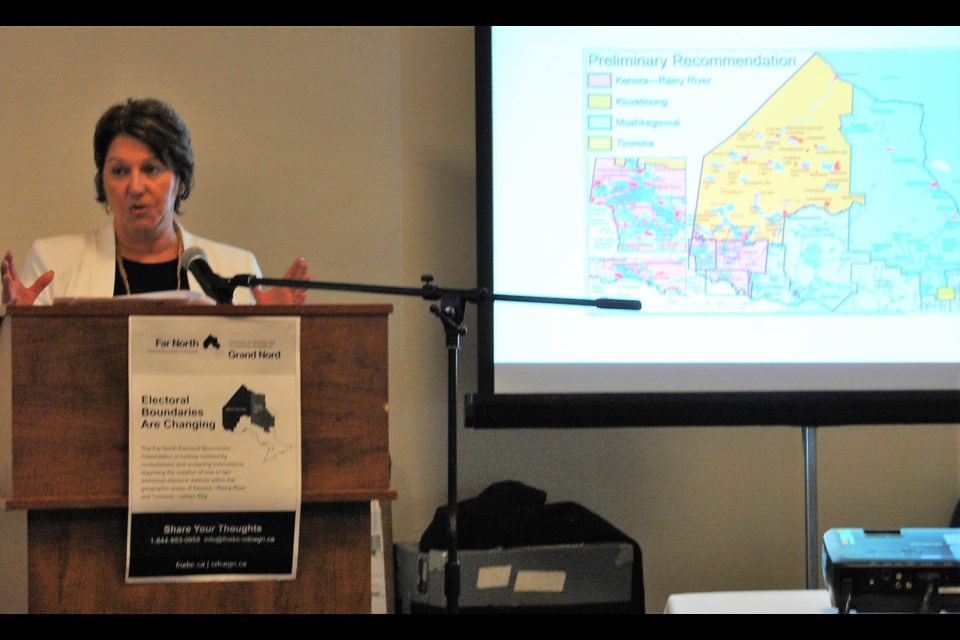The Far North Electoral Boundaries Commission (FNEBC) held its final public meeting in Hearst on Thursday night, and wrapped up its public consultation into the creation of one and possibly two new ridings.
The commission headed by Judge Joyce Pelletier of Thunder Bay, must now submit its final report, and recommendations to the Attorney General of Ontario by August 1.
The FNEBC was in Timmins on Tuesday night July 12, for a final round of public consultation at the Senator Hotel.
The mandate of commission comes from the Representation Act.
“Our mandate is very specific – it says that we must make recommendations with respect to creation of at least one and no more than two additional electoral districts with Kenora—Rainy River and Timmins—James Bay,” Judge Pelletier informed the members of the public.
The preliminary proposal called for two new ridings carved out of the existing Kenora—Rainy River and Timmins—James Bay ridings.
http://fnebc-cdcegn.ca/en/home/
Kiiewetinong riding would extend from the northern half of Kenora Rainy River riding. The southern portion, extending to the US border would include Kenora, Rainy River, Dryden and retain the Kenora—Rainy River name.
A new riding of Mushkegowuk would run from Highway 11 north of Timmins to the James Bay coastal communities.
An urban-based riding of Timmins, would follow its municipal boundaries.
The proposal was arrived at during the first round of public consultations that ran from May 2 to June 23.
The Ontario government must introduce legislation creating two new ridings prior to October 30 for the changes to apply for October 2018 provincial election.
In making its preliminary recommendation, the commission had to balance the criteria in the Representation Act, with a Supreme Court of Canada decision requires voter parity in ridings
“It was difficult to balance the statutory criteria and voter parity,” Pelletier remarked.
Creating ridings based on indigenous languages, meant a population base of only 9,000 for the Mushkegowuk riding, and the idea was put aside as it could be challenged under the voter parity ruling.
“The boundaries of the proposed two ridings are very sparse, but at least they are with in range of each others population,” added Pelletier.
Creating an urban Timmins riding falls in line with in Sudbury and, Sault Ste. Marie ridings.
The proposed Kiiewetinong riding would have a population of 32,784 with 60 percent being indigenous and two percent francophone.
Kenora—Rainy River Riding would have a population of 53,010, with 13 percent indigenous and two percent francophone mix.
The Mushkegowuk riding would have a population of 29,687, with 15 percent being indigenous and 61 percent francophone.
The Timmins riding population would be 41,788, with a three percent indigenous population and a 39 percent francophone population.
The small gathering attending the meeting that totalled 15 individuals including Mayor Steve Black and Gilles Bisson, the MPP for Timmins—James Bay, was mixed on the interim proposal.
Timmins Mayor Steve Black supported the interim recommendations as being the most reasonable given the mandate of the commission and restrictions placed on what it could do,
“I just want to say good job in going through this process,” said Mayor Steve Black. “The fact that you have only 12 people in this room most of us with political affiliations is a sign that you have not upset the political apple cart with your preliminary proposal.”
“Whether the preliminary riding option is acceptable is for the First Nations along the coast to decide,” Mayor Black said.
“If they are happy with this proposal, then it is a good proposal, but if they are not happy then you haven’t addressed their need for representation,” he added.
Michelle Boileau, Liaison Officer for College Boreal supported the recommendations.
“This is something we are okay with,” Boileau said. “I was concerned about excluding the Highway 11 corridor from the Timmins riding, but after reading the proposal I do like this model, because you are developing an urban riding like Sudbury and Sault Ste. Marie; we are trying to grow as an urban centre and that makes our interests different from the rural areas.”
Gilles Bisson, MPP for Timmins—James Bay felt the population of the Mushkegowuk riding would fail to result in an election of an indigenous representative.
“I am disappointed with the recommendations,” said Bisson. “Our First Nations brothers and sisters in Timmins, and the James Bay coast want one of their own in the Legislature.”
“This recommendation doesn’t change anything,” added Bisson. “The proposed riding looks like the old Cochrane North riding, and in that riding the elected representatives came from the Highway 11 corridor.”
“This does not meet the objective of reconciliation and will not lead to increased indigenous representation,” Bisson said.
Pat Chilton, the President of Five Nations Energy believes the recommendations will not meet the objective of electing more indigenous representatives.
"I don't think including the James Bay communities in a riding with the communities in the Highway 11 corridor will work out," Chilton said. "It will be very difficult to get an indigenous member elected with only 15 percent of the population.
Danys Racicot, a resident from Timmins, believed the smaller Timmins riding would lose clout, and the association of the francophone community along the Highway 11 corridor to Timmins would be lost.
Historically, the Highway 11 corridor has been associated with Timmins for such as educational, district services board, public health and other services.
Gerry Corville, from Cochrane, called for a broader reorganization and realignment of northern ridings based on interest.
“Kirkland Lake, all the way to Virginia town should be aligned with Timmins because their shared mining activities,” noted Corville. “Instead Kirkland Lake is now in a riding that contains primarily agricultural communities in the Little Clay Belt from Englehart to Temiskaming Shores and Temagami.”



